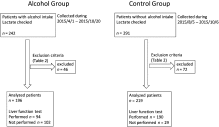Quantitative analysis of high plasma lactate concentration in ED patients after alcohol intake☆
Correspondence
- Corresponding author at: 7-3-1, Hongo, Bunkyo-ku, Tokyo, 1138655 Japan. Tel.: +81 3 3815 5411.

Correspondence
- Corresponding author at: 7-3-1, Hongo, Bunkyo-ku, Tokyo, 1138655 Japan. Tel.: +81 3 3815 5411.
 Article Info
Article Info
To view the full text, please login as a subscribed user or purchase a subscription. Click here to view the full text on ScienceDirect.

Fig. 1
Patient collection algorithm.
Fig. 2
Venous lactate concentration comparison. 2-1, Venous lactate concentrations of all patients analyzed in each group. 2-2, Venous lactate concentrations of patients who underwent liver function tests. 2-3, Venous lactate concentrations of simple alcohol intoxication patients.
Fig. 3
Share of patients with higher lactate concentrations in each group.
Fig. 4
Venous lactate concentration according to consciousness level in alcohol group.
Abstract
Introduction
Plasma lactate concentration is known to increase after alcohol intake. However, this increase has rarely been analyzed quantitatively in emergency department (ED) settings. Evaluating plasma lactate elevation in ED patients after alcohol intake is important because it can affect patients' evaluation based on the plasma lactate level.
Methods
This study analyzed venous lactate concentrations of 196 continuous patients presented to our ED after alcohol intake. The control group comprised 219 successive ED patients without alcohol intake. Patients who had conditions that might induce lactate elevation were excluded from both groups.
Results
Venous lactate concentration was significantly higher in the alcohol intake group (2.83 mmol/L; 95% confidence interval, 2.69-2.96 mmol/L) than in the control group (1.65 mmol/L; 95% confidence interval, 1.53-1.77 mmol/L; P < .05). Lactate concentrations exceeding 3 mmol/L and exceeding 4 mmol/L were found, respectively, in 41.8% and 12.2% of the alcohol intake group compared with in 8.7% and 2.3% of the control group (P < .05). Lactate concentrations do not correlate with patients' level of consciousness. Therefore, a higher plasma ethanol level is apparently unrelated to elevated lactate.
Discussion and conclusion
Analyses show that plasma lactate concentration is significantly higher in ED patients after alcohol intake and to a greater degree than previously reported, even in patients without previously known alcohol-related diseases. Emergency department physicians must be careful when interpreting the lactate level of the patients with alcohol intake.
To access this article, please choose from the options below
Purchase access to this article
Claim Access
If you are a current subscriber with Society Membership or an Account Number, claim your access now.
Subscribe to this title
Purchase a subscription to gain access to this and all other articles in this journal.
Institutional Access
Visit ScienceDirect to see if you have access via your institution.
☆Financial support and conflicts of interests: None for all authors.
Related Articles
Searching for related articles..



